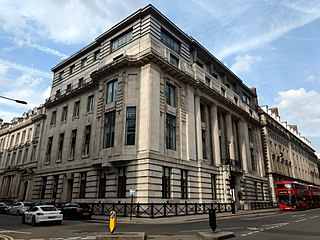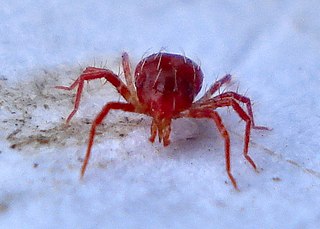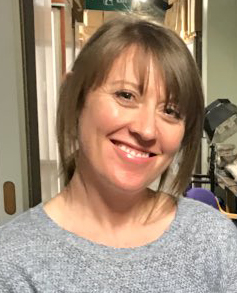Related Research Articles

The Acari are a taxon of arachnids that contains mites and ticks. The diversity of the Acari is extraordinary and their fossil history goes back to at least the early Devonian period. Acarologists have proposed a complex set of taxonomic ranks to classify mites. In most modern treatments, the Acari are considered a subclass of the Arachnida and are composed of two or three superorders or orders: Acariformes, Parasitiformes, and Opilioacariformes; the latter is often considered a subgroup within the Parasitiformes. The monophyly of the Acari is open to debate, and the relationships of the acarines to other arachnids is not at all clear. In older treatments, the subgroups of the Acarina were placed at order rank, but as their own subdivisions have become better understood, treating them at the superorder rank is more usual.

The Natural History Museum in London is a natural history museum that exhibits a vast range of specimens from various segments of natural history. It is one of three major museums on Exhibition Road in South Kensington, the others being the Science Museum and the Victoria and Albert Museum. The Natural History Museum's main frontage, however, is on Cromwell Road.

The Royal Society of Chemistry (RSC) is a learned society in the United Kingdom with the goal of "advancing the chemical sciences". It was formed in 1980 from the amalgamation of the Chemical Society, the Royal Institute of Chemistry, the Faraday Society, and the Society for Analytical Chemistry with a new Royal Charter and the dual role of learned society and professional body. At its inception, the Society had a combined membership of 34,000 in the UK and a further 8,000 abroad. The headquarters of the Society are at Burlington House, Piccadilly, London. It also has offices in Thomas Graham House in Cambridge where RSC Publishing is based. The Society has offices in the United States at the University City Science Center, Philadelphia, in both Beijing and Shanghai, China and Bangalore, India.

Acarology is the study of mites and ticks, the animals in the order Acarina. It is a subfield of arachnology, a subdiscipline of the field of zoology. A zoologist specializing in acarology is called an acarologist. Acarologists may also be parasitologists because many members of Acarina are parasitic. Many acarologists are studying around the world both professionally and as amateurs. The discipline is a developing science and long-awaited research has been provided for it in more recent history.

The Natural History Museum Vienna is a large natural history museum located in Vienna, Austria. It is one of the most important natural history museums worldwide.

The Royal Society of Medicine (RSM) is one of the major providers of accredited postgraduate medical education in the United Kingdom. Each year, the RSM organises over 400 academic and public events. Spanning 55 areas of special interest providing a multi-disciplinary forum for discussion and debate. The RSM is home to one of the largest medical libraries in Europe, with an extensive collection of books, journals, electronic journals and online medical databases. As well as providing medical education, the Society aims to promote an exchange of information and ideas on the science, practice and organisation of medicine, both within the health professions and with responsible and informed public opinion. The Society is not a policy-making body and does not issue guidelines or standards of care.

Nepticulidae is a family of very small moths with a worldwide distribution. They are characterised by eyecaps over the eyes. These pigmy moths or midget moths, as they are commonly known, include the smallest of all living moths, with a wingspan that can be as little as 3 mm in the case of the European pigmy sorrel moth, but more usually 3.5–10 mm. The wings of adult moths are narrow and lanceolate, sometimes with metallic markings, and with the venation very simplified compared to most other moths.

The Digital Classicist is a community of those interested in the application of digital humanities to the field of classics and to ancient world studies more generally. The project claims the twin aims of bringing together scholars and students with an interest in computing and the ancient world, and disseminating advice and experience to the classics discipline at large. The Digital Classicist was founded in 2005 as a collaborative project based at King's College London and the University of Kentucky, with editors and advisors from the classics discipline at large.

The Phytoseiidae are a family of mites which feed on thrips and other mite species. They are often used as a biological control agent for managing mite pests. Because of their usefulness as biological control agents, interest in phytoseiids has steadily increased over the past century. In 1950, there were 34 known species. Today, there are 2,731 documented species.
The Hardy Plant Society is a British charity that promotes the cultivation of hardy herbaceous plants. The Society was founded in 1957 by a group of gardeners and nurserymen. It has approximately 7,500 members and provides information about familiar and less well known perennials, how to grow them and where they may be obtained. The Society also works towards ensuring that garden-worthy perennial plants remain in cultivation and have the widest distribution. Its President is Roy Lancaster.

Harry Hoogstraal was an American entomologist and parasitologist. He was described as "the greatest authority on ticks and tickborne diseases who ever lived." The American Society of Tropical Medicine and Hygiene's Harry Hoogstraal Medal for Outstanding Achievement in Medical Entomology honors his contributions to science.

Amblyomma maculatum is a species of tick in the genus Amblyomma. Immatures usually infest small mammals and birds that dwell on the ground; cotton rats may be particularly favored hosts. Some recorded hosts include:

Ixodes hexagonus, also known by its common name the Hedgehog tick, is a tick species in the genus Ixodes. It is a parasite of the European hedgehog.
Geoffrey Allan Boxshall FRS is a British zoologist, and Merit researcher at the Natural History Museum, working primarily on copepods.
The Design Research Society (DRS), founded in the United Kingdom in 1966, is an international society for developing and supporting the interests of the design research community. The primary purpose of the DRS, as embodied in its first statement of rules, is to promote ‘the study of and research into the process of designing in all its many fields'. This established the intention of being an interdisciplinary learned society, taking a scholarly and domain independent view of the process of designing. Membership is open to anyone interested in design research, and members with established experience and a strong background in design research may apply to be elected as a DRS Fellow.
Systematic & Applied Acarology is a peer-reviewed scientific journal covering research on mites and ticks published trianually by the Systematic & Applied Acarology Society.

The Micropalaeontological Society (TMS) is a scientific society based in the UK but with international membership, it was founded in 1970 for the promotion of the study of micropalaeontology.
The International Society for the Linguistics of English (ISLE), founded in 2008, is a learned society of linguists. The organization’s goals are to promote the study of the English Language at an international level, with a particular focus on the structure and history of standard as well as the many non-standard varieties of English, examining both their form and function. To that end, the society aims to provide a geographically and theoretically neutral central contact point for scholars who identify with these aims by including both academic linguists and members of the educated public who have an interest in English linguistics. The society allows scholars the opportunity convene beyond borders of members' country-specific professional societies. Any person may become an ISLE member by contacting the Secretary and paying dues.
Ooencyrtus marcelloi is a parasitic wasp belonging to the family Encyrtidae. The species was first discovered in 2008 in a tropical lowland rainforest in the Soberanía National Park around Gamboa, Panama. The scientific name was first published in 2010.

Susannah Catherine Rose Maidment is a British palaeontologist at the Natural History Museum, London. She is internationally recognised for her research on ornithischian dinosaur evolution, and was awarded the 2016 Hodson Award of the Palaeontological Association and the 2017 Lyell Fund of the Geological Society of London. She was featured as a 2019 National Geographic Women of Impact.
References
- ↑ Systematic & Applied Acarology Society: Aims and Objectives, http://www.nhm.ac.uk/hosted_sites/acarology/saas/aim.html, accessed 27 Oct 2012.
- ↑ Systematic & Applied Acarology Society: Publications, http://www.nhm.ac.uk/hosted_sites/acarology/saas/publication.html, Last updated 2 April 2008,